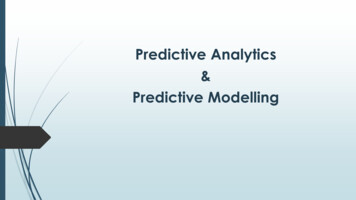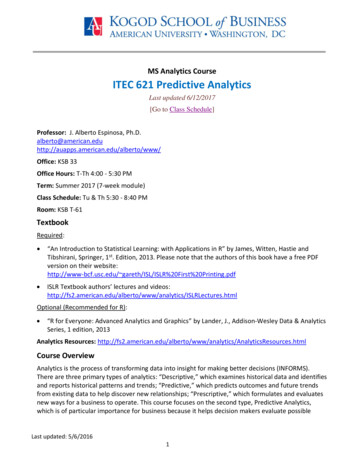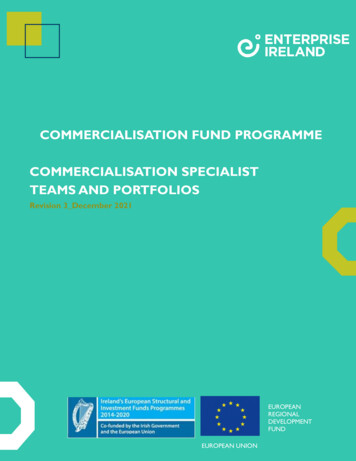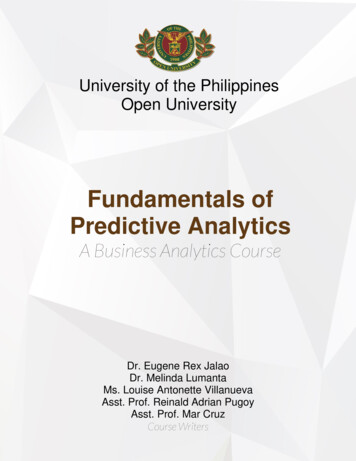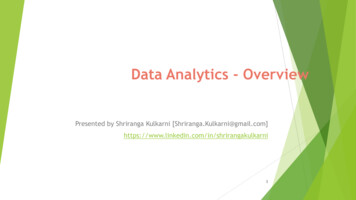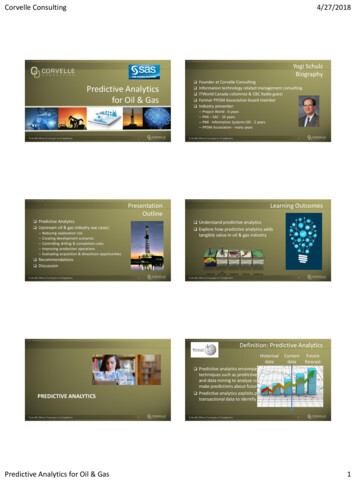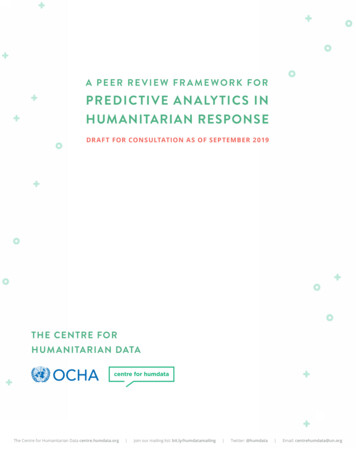
Transcription
A PEER RE VIEW FRA MEWORK FORPREDIC TIVE ANALY TICS INHUMANITARIAN RESPONSEDR AF T FOR CONSULTATION A S OF SEPTEMBER 2019THE CENTRE FORHUM ANITARIAN DATAThe Centre for Humanitarian Data centre.humdata.org Join our mailing list: bit.ly/humdatamailing Twitter: @humdata Email: centrehumdata@un.org
1. IntroductionHumanitarian decision-makers have called for the increased use of predictive analyticsto inform anticipatory action. However, translating the outputs of predictive models intotimely and appropriate responses remains a challenge for several reasons: First, there is no common standard or mechanism for assessing the technicalrigor of predictive models in the sector. Second, the development of predictive models is often led by technicalspecialists who may not consider important ethical concerns , such as theconsequences of a false positive (a model output that predicts a crisis when onedoes not manifest) or a false negative (a model output that fails to predict a crisisthat occurs). Third, model outputs may not be actionable or relevant for humanitariandecision-making due to mandate, policy, resource, or other constraints.The Centre for Humanitarian Data (‘the Centre’) has been working with our partners tounderstand the current state of model development and use in humanitarian operations.We have noted a clear desire for quality assurance of models by partners, with theCentre identified as having a unique role to facilitate a peer review process.Initially developed as part of the Centre’s 2019 Data Fellows Programme, the followingPeer Review Framework for Predictive Analytics in Humanitarian Response is our firstattempt to create standards and processes for the use of models in our sector. It isbased on research with experts and stakeholders across a range of organizations thatdesign and use predictive analytics. The Framework draws on best practices fromacademia and the private sector.Peer review is one of three areas of focus for the Centre’s predictive analyticsworkstream. We also work on developing new models and supporting existing partnermodels for use in humanitarian operations, and on community and capacity building.Learn more about our work on predictive analytics here .The Centre for Humanitarian Data centre.humdata.org Join our mailing list: bit.ly/humdatamailing Twitter: @humdata Email: centrehumdata@un.org2
2. Peer Review FrameworkThe Framework consists of three steps: 1) Readiness Assessment; 2) Model Review;and 3) Assessment and Results. The duration for review will depend on thecompleteness and quality of the submission by the partner organization. We estimatethat the review may take anywhere from one to two months.In the first step , the Centre will assess the readiness of a model for peer review. Wewill work with the partner to understand the model objectives, the crisis setting, and theaction that the model output will inform.In the second step , the model will be assessed against three criteria: technical, ethical,and humanitarian relevance. For this, the Centre will invite experts to engage in thereview process.In the third step , the Centre will convene the reviewers to discuss the findings. Aresults package will be developed that includes findings across each domain and thefinal assessment of the model. This package is shared with the partner privately. Thepartner may decide to revise their submission based on the findings and would have theultimate say in whether the results are shared publicly.3. Roles in the Peer Review ProcessThe Centre will lead the process and will work with experts to complete the review. Thepartner organization will be asked to identify a single focal point for the processalthough different colleagues may need to be involved for each step.The roles include: The Client: an organization submitting a model for peer review. Ethical Reviewer: an individual with demonstrated expertise in practical andhumanitarian ethics. Humanitarian Relevance Reviewer: an individual with demonstrated sectoralexpertise in the relevant context.The Centre for Humanitarian Data centre.humdata.org Join our mailing list: bit.ly/humdatamailing Twitter: @humdata Email: centrehumdata@un.org3
Technical Reviewer: an individual with demonstrated expertise in data scienceand statistics. Moderator: a member of the Centre’s Predictive Analytics team designated bythe Predictive Analytics Team Lead on a case-by-case basis.3.1 The ClientThe client initiates the process through a direct request to the Centre’s PredictiveAnalytics Lead. Models may be submitted for peer review by organizations developing amodel, or by organizations planning to use model outputs for decisions.3.2 ReviewersThe Centre will invite experts to submit a brief application to become a reviewer in oneof the domains -- ethical, humanitarian relevance, or technical. Once accepted, thereviewer will become part of a reviewer pool which will be managed by the Centre. Themoderator will select reviewers based on availability and a match of skills for the modelin reference. Reviewers will not be assigned to review models submitted by their ownorganization. The reviewer role is unpaid.3.3 The ModeratorThe Centre’s Predictive Analytics Lead appoints a member of the Centre’s team to actas moderator to each review. Following the initial request for model review, themoderator is the point-of-contact for the client and the reviewers.4. Readiness AssessmentIn the first step, the Centre assesses the readiness of a model for peer review byconducting a viability call at the request of the client within 7 days of receiving thesubmission. During this call, a member of the Centre’s Predictive Analytics team willguide the Client through the Readiness Assessment (see Annex A).The objectives of the viability call are to:a) Determine whether the model aligns with the Centre’s work and objectives; andb) Assess the feasibility of reviewing the model.Using the Readiness Assessment, the moderator will collect information needed tocontinue with the review, including an overview of the model and the availability ofsupporting materials. The client is asked to provide information about the model,describe how the outputs are expected to inform action, and confirm whether theThe Centre for Humanitarian Data centre.humdata.org Join our mailing list: bit.ly/humdatamailing Twitter: @humdata Email: centrehumdata@un.org4
development code, methodology documentation and data will be made available forreview.Should the Readiness Assessment criteria not be met, the moderator will inform theclient of the decision and share the report highlighting steps that need to be taken forthe model to be reviewed. Should the model meet the Readiness Assessment criteria,the Client will be informed that the model will be reviewed and will be provided with atimeline.5. Peer ReviewThe model is assessed against the criteria for ethical, humanitarian relevance andtechnical domains by the reviewers. To initiate this step, the client submits supportingmaterials (e.g. development code, methods documentation) to the moderator. The clientmay request supporting materials be treated confidentially.The moderator sends invitations to ethical, humanitarian relevance and technicalreviewers based on their domain expertise. Reviewers are asked to accept the invitationto review within 3 business days. Additional reviewers are contacted until each positionis filled. Up to 7 days are allocated to identify reviewers. The moderator provides thereviewers with templates addressing criteria across the ethical, humanitarian relevanceand technical domains.5.1 Ethical ReviewThe ethical considerations of the model will be assessed using the Ethical Matrix(Annex B) which has been adopted from the work of Cathy O’Neil.1 The ethical reviewerwill identify all stakeholders and concerns regarding how the model could be used. Forinstance, a model may need to be adjusted in a scenario in which a false negative isunacceptable for affected populations or a false positive is unacceptable for a donor.The matrix will be filled in in collaboration with the client.5.2 Humanitarian Relevance ReviewThe actionability of the model output will be assessed using the HumanitarianRelevance Checklist (Annex C). The Humanitarian Relevance reviewer will assess themodel output in consideration of the crisis context, output reliability and interpretation,and stakeholder engagement. O’Neil, C. Weapons of Math Destruction: How Big Data Increases Inequality and Threatens Democracy. CrownPublishing Group New York, NY, USA, 2016.1The Centre for Humanitarian Data centre.humdata.org Join our mailing list: bit.ly/humdatamailing Twitter: @humdata Email: centrehumdata@un.org5
5.3 Technical ReviewThe Technical Checklist (Annex D) is designed to assess the scope and methodology ofthe model. The technical reviewer will assess the code and technical documentation ofthe model to identify and evaluate the theoretical foundations, data sources,parameters, analysis methods, limitations, and interpretations. If applicable, thetechnical reviewer will reproduce the results using the code and technicaldocumentation.6. Assessment and RecommendationsReviewers will complete the templates (Ethical Matrix, Humanitarian RelevanceChecklist and Technical Checklist) with their assessment within an agreed amount oftime. Reviewers may request additional information or clarification from the client via themoderator during this time. Reviewers will be asked to sign their review at submission.The moderator the convenes all reviewers to discuss the findings. The moderatorprepares the Assessment and Results report (Annex E), detailing how the model outputmay be interpreted and its reliability, as well as the key components of each review.The moderator shares the recommendation package with the client privately. The clientmay decide to revise their submission based on the findings and would have theultimate say in whether some or all the results are shared publicly.***FeedbackThe Centre invites relevant individuals and organizations working in the humanitarian,academic, research and private sector to engage with us on the peer review process.Please send feedback on the framework to centrehumdata@un.org .AcknowledgementsThe draft Framework was initially developed by Dani Poole who worked as a DataFellow with the Centre during the 2019 Data Fellows Programme in June and July TheHague. As part of her research, Dani conducted interviews with over 20 expertsincluding data scientists, researchers, ethicists, and decision makers spanning thehumanitarian, academic, and private sectors. The draft Framework was further detailedwith input from Leonardo Milano, Stuart Campo, Manu Singh, and Kirsten Gelsdorf,among others. W e appreciate the time and consideration of the many people who havecontributed to this process.The Centre for Humanitarian Data centre.humdata.org Join our mailing list: bit.ly/humdatamailing Twitter: @humdata Email: centrehumdata@un.org6
I. Annex APeer Review Framework - Readiness AssessmentThe moderator will use the Readiness Assessment template to record information regardingeach item. The client may request to see the Readiness Assessment template in preparation fora peer review request.Centre’s Predictive Analytics Team Member:The Client:Review request initiated: / /Readiness Assessment: / /DomainItemDescription1Summarize the prediction problem (i.e. model objectives, setting,affected population, predictors, and proposed interpretation of theoutput):2List any partners and their role in model development and proposeduse, including funding sources:3Define the outcome to be predicted:4Identify the key techniques used to build the model:5Describe the action that the model output will inform:6Describe any initial ethical concerns:7Summarize engagement with stakeholders:Model overviewAvailability of supporting materials8State whether the development code will be available for review:9State whether the data will be available for review:The Centre for Humanitarian Data centre.humdata.org Join our mailing list: bit.ly/humdatamailing Twitter: @humdata Email: centrehumdata@un.org7
II. Annex BPeer Review Framework - Ethical MatrixThe Ethical Matrix is to be used by the ethical reviewer. The moderator should share the matrixwith the client in preparation for peer review. The following questions should be answered withthe client before completing the more detailed ethical matrix below. Does the design and development of the model include human subjects research? [Yes /No]Is there a ‘Risk, Harm, and Benefit Assessment’ included with the model documentation,including measures to minimize adverse effects of the model? [Yes/No]In cases where personal data (either as microdata or in aggregate form) is included asan input to the model, does the analytical approach and intended use of the modeloutputs align with the consent provided at data collection? [Yes / No]Have adequate measures been taken in the model development to ensure data privacyand security and prevent the reidentification of individuals or vulnerable groups duringthe modeling process and/or in the model outputs? [Yes / No]In what ways could the model perpetuate and encode past mistake (e.g. ossification)?Based on the reviewer’s understanding of the model and its intended application, the EthicalMatrix should be completed.Concern onsequences:The Centre for Humanitarian Data centre.humdata.orgGoodWorrisome Join our mailing list: bit.ly/humdatamailing Twitter: @humdata Email: centrehumdata@un.org8
Consequences:GoodWorrisomeBadIII. Annex CPeer Review Framework - Humanitarian Relevance ChecklistThe Humanitarian Relevance Checklist incorporates domains identified by humanitarianpractitioners and scholars as critical to the translation of predictive analytics to action.DomainItemChecklist ItemModel output1aIs the output provided in a useful form?1bIs the output consistent with government policy in the recipientcountry?1cIs the output consistent with established triggers for action?1dHas the output been ground truthed?Timeliness2How frequently are outputs updated? What is the lag betweenthe output and action?Impact3aAre the outputs actionable?3bIs there a funding mechanism using the output?3cIs there local capacity for action?3dAre there other inputs required for decision making?4aAre there competing models? If so, what is the benefit of usingthe model under review?4bHas the Client made an attempt to synthesize a single andconsistent message to facilitate decision making?CoordinationThe Centre for Humanitarian Data centre.humdata.org Join our mailing list: bit.ly/humdatamailing Twitter: @humdata Email: centrehumdata@un.org9
IV. Annex DPeer Review Framework - Technical ChecklistDomainItemDescriptionPage1Data source1aDescribe the data source and whether the data ispublically available (list separately for the developmentand validation datasets, if applicable.)1bSpecify the start date and end date of the dataset(s).1cRemark on the quality of the data.1dProvide summary statistics of the data used in the model(mean, median, standard deviation).Input2Clearly define all predictors used in developing orvalidating the model, including how and when they weremeasured.Output3Clearly define the output format (e.g. probability, realnumbers) with confidence intervals if computable.Missing data4Describe how missing data were handled (e.g., exclusion,single imputation, multiple imputation) with details of anyimputation method.Assumptions5Summarize model assumptions and approximations.Bias6Identify sources of potential bias.Analysismethods7aSpecify type of model, all model-building procedures(including predictor selection and calibration), andmethods for internal validation (e.g. random forest withunivariate feature correlation, GLM checking formulticollinearity).7bSpecify all measures used to assess model performanceand, if relevant, to comparemultiple models.7cDescribe any model updating (e.g., recalibration) arisingfrom the validation, if done.7dExplain how the data was divided for validation, training,If available, the Client may indicate the page of the code or other documentation on which the item isaddressed.1The Centre for Humanitarian Data centre.humdata.org Join our mailing list: bit.ly/humdatamailing Twitter: @humdata Email: centrehumdata@un.org10
The Centre for Humanitarian Data centre.humdata.org Join our mailing list: bit.ly/humdatamailing Twitter: @humdata Email: centrehumdata@un.org11
The Centre for Humanitarian Data centre.humdata.org Join our mailing list: bit.ly/humdatamailing Twitter: @humdata Email: centrehumdata@un.org12
Moderator: a member of the Centre's Predictive Analytics team designated by the Predictive Analytics Team Lead on a case-by-case basis. 3.1 The Client The client initiates the process through a direct request to the Centre's Predictive Analytics Lead. Models may be submitted for peer review by organizations developing a



